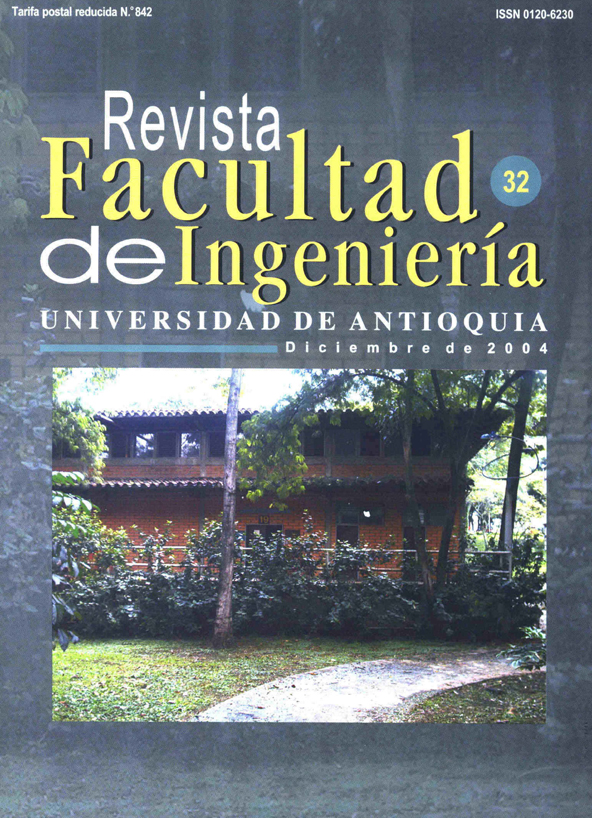Synthesis methods of new transition metal materials
DOI:
https://doi.org/10.17533/udea.redin.344341Keywords:
methods of synthesis, solid state, transition metals, new materials, inorganic solidsAbstract
The main subject of this manuscript is the synthesis of porous solids with transition metals and the evolution of the techniques involved, first, a short but illustrated concepts about transition metals is introduced, emphasizing the importance of oxides in obtaining high technology materials. Subsequently, methods of synthesis and general characteristics are presented. This review can be of great use for the reader interested in solid state synthesis, because the information found in the open literature is very little and fragmented.
Downloads
References
Rangel, C. Los materiales de la civilización. Fondo de Cultura Económica. 2.ª ed. México, 1994.
Askeland, D. Ciencia e ingeniería de los materiales. 3.ª ed. International Thomson Editores. México, 1998.
Kizilyalli, M. Solid-state chemistry: review and development of teaching materials and definition of terms. IUPAC Congress. 2001.
Larsen, E. Elementos de transición. Ed. Reverté S. A. Barcelona, 1972.
Stein, A.; Keller, S. y Mallouk, T. “Turning down the heat: design and mechanism in solid-state synthesis”. En: Science. N.° 259. 1993. pp. 1558-1564. DOI: https://doi.org/10.1126/science.259.5101.1558
Schwarz, J.; Contescu, C. y Contescu, A. “Methods for preparation of catalytic materials”. En: Chemical Reviews. N.° 95. 1995. pp. 477-510. DOI: https://doi.org/10.1021/cr00035a002
http://mesun4.wustl.edu/ME7apsl/hpright.htm.
http://www.uned.es/cristamine/gemas/sintesis/flux.htm.
http://python.rice.edu/~arb/chemcontrol.htm.
Livage J. “Synthesis of polyoxovanadates via chimie douce”. En: Coordination Chemistry Reviews. N.° 178-180. 1980. pp. 999-1018. DOI: https://doi.org/10.1016/S0010-8545(98)00105-2
http://www.chemistry.ohio-state.edu/∼woodward/ch754/syn_cd.htm.
http://www.solgel.com/hybrids/hybrids.htm.
Attfield, M. “Microporous materials”. En: Science Progress. No. 85. 2002. pp. 319-345. DOI: https://doi.org/10.3184/003685002783238771
Ma, Y. et al. “A review of zeolites-like porous materials”. En: Microporous and mesoporous materials. N.° 37. 2000. pp. 243-252. DOI: https://doi.org/10.1016/S1387-1811(99)00199-7
Cheetham, A.; Férey, G. and Loiseau, T. “Openframework inorganic materials”. En: Angew. Chem. Int. Ed. N.° 38. 1999. pp. 3268-3292. DOI: https://doi.org/10.1002/(SICI)1521-3773(19991115)38:22<3268::AID-ANIE3268>3.3.CO;2-L
Wan, X.; Liu, L. y Jacobson, A. “Electrochemicalhydrothermal synthesis and structural characterization of Zn2(OH)VO4”. En: Z. anorg. Allg. Chem. N.° 624. 1998. pp. 1.977-1.981. DOI: https://doi.org/10.1002/(SICI)1521-3749(1998120)624:12<1977::AID-ZAAC1977>3.0.CO;2-D
Wan, X.; Liu, L.; Jacobson, A. y Ross, K. “Electrochemical-hydrothermal synthesis and structural characterization of [N(CH3)4]2[Co(H20)4V12O28]”. En: J. Mater. Chem. N.° 9. 1999. pp. 859-861. DOI: https://doi.org/10.1039/a809999e
Badding, J., Meng, J. and Plvani, D. “Pressure tuning in the search of new and improved solid state materials”. En: Chemistry of Materials. N.° 10. 1998. pp. 2889-2894. DOI: https://doi.org/10.1021/cm9802393
Downloads
Published
How to Cite
Issue
Section
License
Revista Facultad de Ingeniería, Universidad de Antioquia is licensed under the Creative Commons Attribution BY-NC-SA 4.0 license. https://creativecommons.org/licenses/by-nc-sa/4.0/deed.en
You are free to:
Share — copy and redistribute the material in any medium or format
Adapt — remix, transform, and build upon the material
Under the following terms:
Attribution — You must give appropriate credit, provide a link to the license, and indicate if changes were made. You may do so in any reasonable manner, but not in any way that suggests the licensor endorses you or your use.
NonCommercial — You may not use the material for commercial purposes.
ShareAlike — If you remix, transform, or build upon the material, you must distribute your contributions under the same license as the original.
The material published in the journal can be distributed, copied and exhibited by third parties if the respective credits are given to the journal. No commercial benefit can be obtained and derivative works must be under the same license terms as the original work.










 Twitter
Twitter